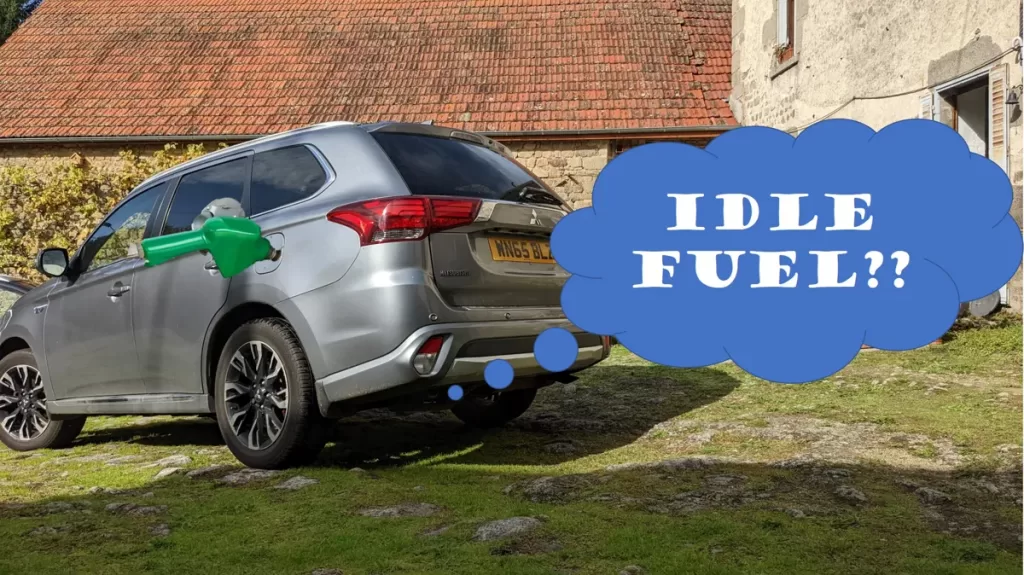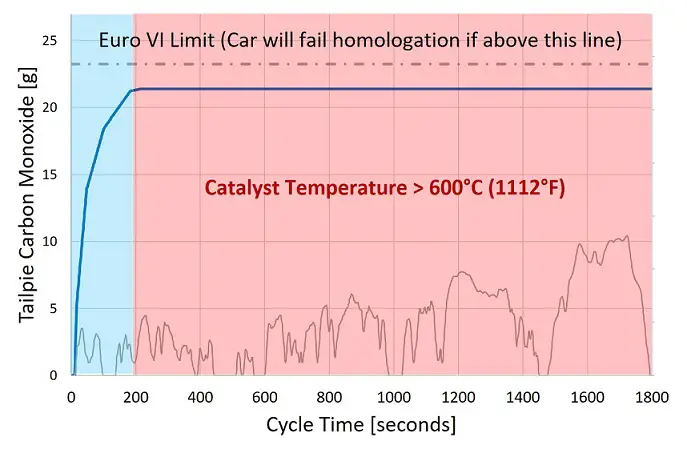Most vehicles will use less than 1 litre per hour to idle. So in theory you could leave your car idling for well over 2 days, assuming that the air con and all other auxiliary loads are switched off before it runs out of fuel!
Table of Contents
How Much Fuel Does An Idling Car Consume?
Here is a table with some typical values for fuel consumption at idle. Check out the calculator I made below if you want to estimate idling fuel consumption for your vehicle.
| Fuel | Engine Size [cc] | Idle Fuel [litre/ hour] |
| Gasoline E0 | 1800 | ~ 0.5 |
| Gasoline E85 | 1800 | ~ 0.7 |
| Gasoline E5 | 3000 | ~ 0.9 |
| Gasoline E10 | 6000 | ~ 1.8 |
| Diesel | 2000 | ~0.5 |
Want to delve into the table above with an estimate for your vehicle? Maybe you are interested in the effect of ethanol on carbon dioxide release?
Please note the volumetric efficiency is set to 40% & 50% for gasoline and diesel respectively. Also the diesel calculation MAP is forced to 100kPa.
These numbers are based on empirical analysis of engine design and operation. They should be treated as estimates and may not be correct. If you want to have more calculators like this for power etc. please leave a comment below, I’d love to hear from you.
OBD Data Capture
If you want to get technical I strongly suggest using an OBD device to read data from the engine ECU. This way you can plug in the numbers to the calculator to reflect your vehicle.
If you drive a Ford, you should definitely be using ForScan for detailed data gathering and analysis. I have previously used ForScan in conjunction with this device which has a physical switch for high speed and medium speed CAN bus:

Cheap generic device; I have had some success with this basic bluetooth OBD dongle which can connect to your phone, it costs less than a fiver!
My recommended goto product which is higher quality and tends to work with more apps, such as PHEV Watchdog, Nissan leaf ‘leaf spy‘ and calibrate my Triumph motorcycle.

Why Idling isn’t Always Bad for the Environment

You may have noticed that hybrids and cars with stop start will idle the engine when they are cold? The reason for this is nothing to do with the engine warming up but actually because the catalytic converter is cold.
The catalytic converter can only work when it is hot and the only way to get it hot is to run hot exhaust gas through it. The ECU will ensure that the catalyst warms up as quickly as possible and will then switch off the engine. Engine calibrators are faced with the option of burning slightly more fuel cleanly vs burning less fuel but when the engine is needed the emissions will be significantly worse, possibly dipping below the legal limit.
The image below explains my point more clearly. The first 200 seconds of the drive cycle the catalyst is cold, so any driving done in this portion has very high tailpipe emissions (in this case carbon monoxide). It is important that the catalyst does not cool down again below the required temperature for conversion.

For more on this check out this post I wrote – Discover What 3 Exhaust Gases a Catalytic Converter Cleans When it’s Working
The Factors That Affect Idling Fuel Consumption?
There are a lot of things that affect fuel consumption at idle. The calculator above gives you some clues and you can adjust all the input variables to see what effect they have. Here is a long list of factors:
- Engine Size (bigger engines typically use more fuel)
- Fuel type (petrol typically needs more fuel to idle)
- Idle speed (higher engine speed will use more fuel)
- Ethanol content in gasoline (higher ethanol content requires more fuel)
- Engine temperature (a cold engine uses more fuel)
- Intake air temperature (warmer air typically lowers fuel consumption – less dense)
- Engine calibration –
- Diesels sometimes do DPF regen, this will dramatically increase fuel consumption when it occurs.
- Catalyst temperature must be maintained, see above, sometimes the idle conditions are modified (spark retard) to warm the catalyst.
Myths About Idling: Debunking the Misconceptions
For many years, idling has been considered a necessary evil when it comes to driving. From warming up the car on a cold day to waiting for passengers or traffic, idling has been a part of our daily routine. When humans do something out of habit, myths tend to emerge to justify these habits – idling in this case. Here are a few myths that need debunking.
One of the most persistent myths is that idling is necessary to warm up a car’s engine. While it’s true that older cars needed to warm up before driving, modern engines are designed to operate efficiently even in cold temperatures. In fact, idling for more than 30 seconds can actually harm the engine by causing unnecessary wear and tear, reducing fuel efficiency and increasing emissions.
Another common myth is that restarting the engine uses more fuel than idling. In reality, modern engines are designed to consume very little fuel during start-up, and the amount used is typically less than what would be used during idling for the same amount of time. Furthermore, the amount of fuel saved by turning off the engine during brief stops, such as at traffic lights or drive-throughs, can add up significantly over time.
Lastly, many people believe that turning off and on the engine repeatedly will cause damage. However, modern engines are designed to handle frequent start-ups without any adverse effects. In fact, idling for prolonged periods can actually cause more damage to the engine by preventing proper lubrication of the cylinders and wearing out the engine components prematurely.
Why Vehicle Manufacturers Use Stop-Start
Are you curious why stop-start technology is gaining popularity even though most cars only use less than 1 litre of fuel per hour to idle? In Europe, every single drop of fuel saved is crucial as teams are constantly working to reduce fuel consumption by tenths of a percent. The focus on efficiency isn’t just in motorsports, but also in the design of mass-produced vehicles. In Formula 1, drivers look for tenths of a second to gain an edge, and in the automotive industry, engineers strive to save every drop of fuel possible. So while it may seem like a small amount, stop-start technology plays a crucial role in improving fuel efficiency and reducing emissions.
Is it Illegal to Leave Your Engine Idling when Parked (UK Rules)
In accordance with the Road Traffic (Vehicle Emissions) (Fixed Penalty) (England) Regulations 2002, keeping a vehicle idling is considered an offense. It is illegal to keep the engine running unnecessarily when stationary. A fixed penalty notice of £20 may be issued if the engine is not turned off after being addressed.
This legislation applies to all kinds of vehicles, including private cars, buses, and taxis, on public roads. However, it is important to note that it does not apply to vehicles that are moving slowly due to road works or congestion, stopped at traffic lights, under repair or testing, or defrosting the windscreen.
Before You Go…
Check out some more carbant posts:

